Lawn Be Gone
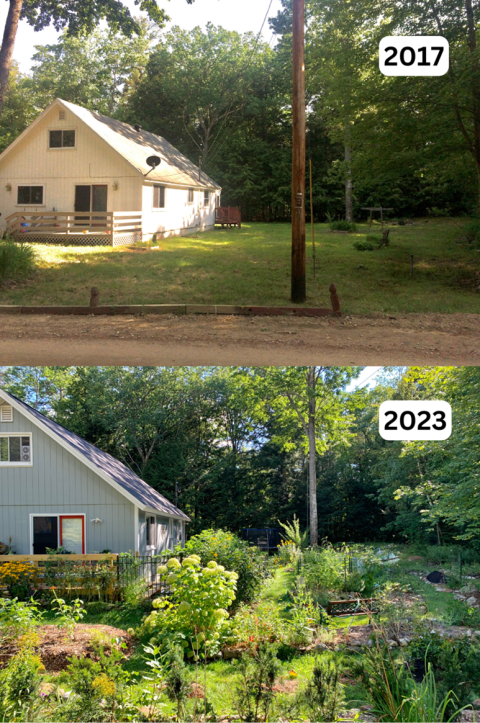
In 2017, my husband and I purchased a foreclosure. With the current housing market, I look back in gratitude, but at the time it was overwhelming. The house is on one-third acre with a large yard aka an ecological dead zone. There was grass to mow and nothing interesting to see. Our focus was making the house livable, so gardening had to wait. The delay was a blessing because that fall I completed the Natural Resource Stewards program with UNH Extension, where I learned the principles of permaculture which helped guide how we thought about our property. Since then we have learned a lot about turning a lawn into a healthy space, a place to remind us that we are not separate from nature, but a part of it. Without a big plan or budget, we have chipped away at the lawn with slow changes.
The manicured lawns we are accustomed to are relatively new. They were status symbols for wealthy Europeans, becoming more popular in the USA after the Civil War, when suburban communities were first laid out here. Americans have continued to love lawns, which look sort of natural because they’re green and growing, but not much can thrive there. We also fertilize and water to make it lush, then mow it down each time it grows. Today lawns cover an estimated 30-40 million acres in the USA alone! They are the largest irrigated crop in America, where we spend billions annually to maintain them. One can’t help but wonder what is the return on this investment? Removing a lawn can seem daunting, but I hope our story encourages others to make this change too.
Know your goals. How will you use your space? Maybe you want an open lawn area for children to play, a wildflower garden, to grow food, or to encourage your favorite bird to visit daily? Your goals will shape how you tackle removing the lawn. I love to walk barefoot in the grassy paths between the beds, so I will never remove 100% of the grass. In books and abroad, a garden is often a place where people enter, but Americans tend to point to “the garden. My goal has been to create a place for family to gather, for food to grow, and bees to thrive, and not something to point at.
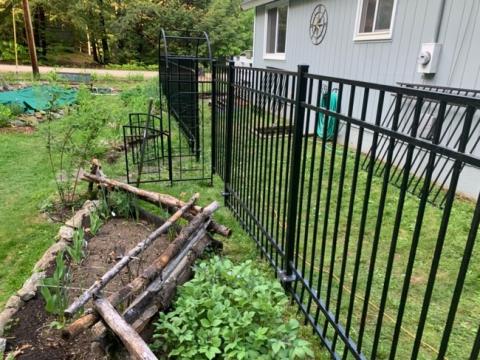
Start small to avoid paralysis by analysis which stops us from making any changes at all. A few containers on a patio are better than nothing! With a small budget, it helps to be flexible. With a larger budget you can move more quickly. Unexpected free materials have created several of my projects. This black fencing (above) replaced our small wooden one after friends needed it removed from their property. It was safer for our puppy and gave us vertical growing space too. When the electric company was clearing space around powerlines on our street, I asked for them to drop the woodchips in our driveway and they did! (Be aware of Japanese knotweed in your area.) The mound was taller than me! It took two days to spread the woodchips around the garden, and there was still so much left that I had no choice but to rake them into a rectangle and start a new bed!
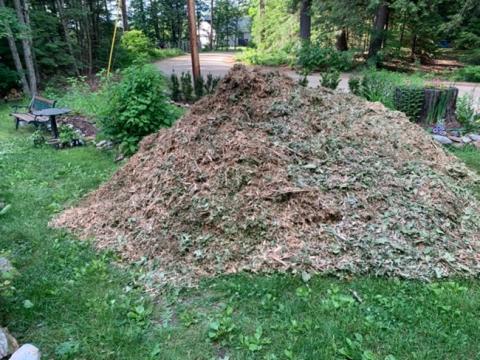
Woodchips from the electric company
Look for available resources. We live in an HOA neighborhood, so it was important that our garden looked landscaped. We could not afford to buy materials for traditional raised beds and used what was available = rocks! We dug up every rock on our property to line our first hügelkultur mounds in 2019, then began asking friends and family for theirs. It is a lot of physical work, but going up is easier than digging into NH ground. We filled the beds with organic materials and topped with compost from a landscaping company. Although that first summer was dry, mushrooms thrived with the corn! This helped reduce watering needs without buying irrigation equipment. Every autumn I mulch fallen leaves and rake them into beds. There are “buy nothing” groups online where people post only free items. I have bought plants at community plant sales, swapped with friends, and grown many from seeds. (Be mindful of spreading jumping worms.)
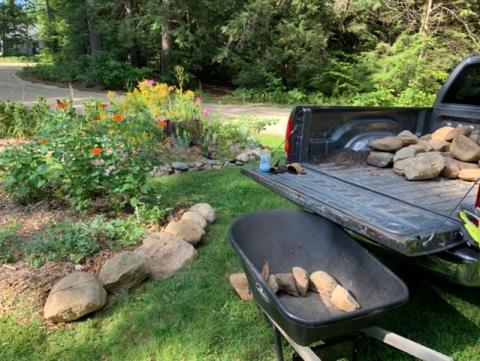
Be comfortable with failure too. Friendly neighbors compliment the garden, and I hold back from pointing to the powdery mildew, the dead flowers, or how badly I pruned the hydrangea. Sometimes I try new things, and it doesn’t work. It doesn’t have to be perfect.
One useful strategy has been to make a theme for each year. I feel less overwhelmed, while still making improvements as I am able. You could choose anything from simple (add more plants for hummingbirds) to more complex (how to build a healthy meadow). Our first summer I utilized permaculture principles. We observed and interacted with the space, watching sun/shade patterns, and considering different areas as “zones.” When the pandemic disrupted everything, we focused on food systems and obtaining a yield for our kitchen. The following year, I practiced seed saving. In 2022, an unexpected job change meant less time for gardening, so I read about ecological gardening. This means treating the garden as an ecosystem: select plants that support biodiversity, hold onto rainwater, provide habitat and food for animals, and/or are edible for people. Perhaps this was to give myself permission to step back, but it was useful taking time to become aware of our backyard ecology. I learned about the huge diversity of wild bees sharing this small space! I saw mantisflies, spider wasps, frogs, snakes, and once watched a flock of songbirds react as a hawk caught a Baltimore Oriole! While harvesting potatoes last year, I noticed this leaf-cutter bee (photo below) cutting leaves across the street and building her nest in our garden. In just six years, this .33-acre lot went from an empty lawn to an increasingly diverse garden. I invite you all to join me in chipping away at the lawn a little more each year.

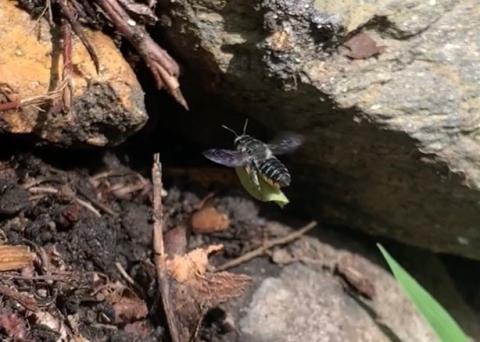
Leaf cutter bee's nest in my rocks. Photo by Rebecca Cowser.
Recommended Reading:
The Living Landscape by Rick Darke & Doug Tallamy
The Foodscape Revolution by Brie Arthur
The Resilient Farm and Homestead by Ben Falk
Edible Landscaping with a Permaculture Twist by Michael Judd
Lawns into Meadows by Owen Wormser
In Defense of Food by Michael Pollan
Down to Earth by Monty Don
Planting in a Post-Wild World by Thomas Rainer and Claudia West
Landscaping with Fruit by Lee Riech
The Spirit of Place by Bill Noble
The Ecological Gardener by Matt Rees-Warren
The Home-Scale Forest Garden by Dani Baker